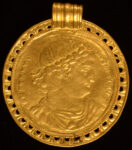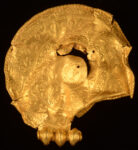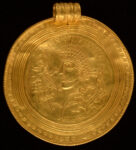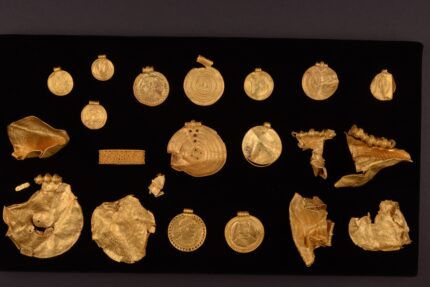A hoard of gold objects from the 6th century has been discovered in a farmed field outside the town of Jelling, South Jutland, Denmark. The 22 objects have a total combined weight of 945 grams, so just under a kilo.
They were discovered in December by metal detectorist Ole Schytz who was new at the hobby and hadn’t even been out with his machine 10 times when he stumbled on one of the largest and most significant gold hoards ever found in Denmark. He alerted authorities and archaeologists from the Vejle Museums excavated the find site, keeping the massive find secret until now to deter looters.
 The hoard contains two Roman gold coins that have been converted into pendants — including a gold solidus of Constantine the Great (285-337 AD) — and one piece of jewelry with gold granulation in an elaborate pattern, but most of the pieces in the hoard are bracteates. Bracteates were round medallions worn as pendants that were made in Northern Europe during the Migration Period. Typically bracteates are penny-sized with rudimentary engravings of figures from Nordic mythology. These are unusually large, the size of small saucers, and
The hoard contains two Roman gold coins that have been converted into pendants — including a gold solidus of Constantine the Great (285-337 AD) — and one piece of jewelry with gold granulation in an elaborate pattern, but most of the pieces in the hoard are bracteates. Bracteates were round medallions worn as pendants that were made in Northern Europe during the Migration Period. Typically bracteates are penny-sized with rudimentary engravings of figures from Nordic mythology. These are unusually large, the size of small saucers, and  the quality of decoration is exceptionally high. They are also unusually varied. Often bracteates found in hoards are very similar in design, but every one of these is different, and there are runs and motifs never seen before on other bracteates.
the quality of decoration is exceptionally high. They are also unusually varied. Often bracteates found in hoards are very similar in design, but every one of these is different, and there are runs and motifs never seen before on other bracteates.
The excavation revealed that the hoard was buried under the floor of a longhouse, and only a very powerful, very wealthy individual could have  collected a treasure this vast. Archaeologists know there was a small town here during the Migration Period, but there was no previous indication that it was sufficiently important to attract a resident who was so massively wealthy and powerful that he could acquire so much gold and attract artisans of such high caliber.
collected a treasure this vast. Archaeologists know there was a small town here during the Migration Period, but there was no previous indication that it was sufficiently important to attract a resident who was so massively wealthy and powerful that he could acquire so much gold and attract artisans of such high caliber.
 Many of the large gold hoards discovered in Scandinavia from this period are believed to have been buried as desperate offerings to appease the gods after a volcanic eruption in 535/536 A.D. generated an ash cloud that blocked the sun and caused widespread crop failure and famine. If it was not an offering, the hoard may have been buried to protect it from being stolen during this turbulent time.
Many of the large gold hoards discovered in Scandinavia from this period are believed to have been buried as desperate offerings to appease the gods after a volcanic eruption in 535/536 A.D. generated an ash cloud that blocked the sun and caused widespread crop failure and famine. If it was not an offering, the hoard may have been buried to protect it from being stolen during this turbulent time.
One of the bracteates features the profile of a male head with a braid of hair. A bird is in front of him — they appear to be conversing — and under him is a horse. Between the horse’s head and front legs is a runic inscription that a preliminary translation interprets as “houaʀ” meaning “the High.” This may be a reference to the leader who buried the hoard, or the god Odin.
 The gold objects are currently being conserved. The folded and bent pieces will be straightened out as much as prudence allows. In February, they will go on display at the Vejle Art Museum.
The gold objects are currently being conserved. The folded and bent pieces will be straightened out as much as prudence allows. In February, they will go on display at the Vejle Art Museum.
